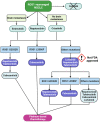From Development to Place in Therapy of Lorlatinib for the Treatment of ALK and ROS1 Rearranged Non-Small Cell Lung Cancer (NSCLC)
- PMID: 38201357
- PMCID: PMC10804309
- DOI: 10.3390/diagnostics14010048
From Development to Place in Therapy of Lorlatinib for the Treatment of ALK and ROS1 Rearranged Non-Small Cell Lung Cancer (NSCLC)
Abstract
Following the results of the CROWN phase III trial, the third-generation macrocyclic ALK inhibitor lorlatinib has been introduced as a salvage option after the failure of a first-line TKI in ALK-rearranged NSCLC, while its precise role in the therapeutic algorithm of ROS1 positive disease is still to be completely defined. The ability to overcome acquired resistance to prior generation TKIs (alectinib, brigatinib, ceritinib, and crizotinib) and the high intracranial activity in brain metastatic disease thanks to increased blood-brain barrier penetration are the reasons for the growing popularity and interest in this molecule. Nevertheless, the major vulnerability of this drug resides in a peculiar profile of related collateral events, with neurological impairment being the most conflicting and debated clinical issue. The cognitive safety concern, the susceptibility to heterogeneous resistance pathways, and the absence of a valid alternative in the second line are strongly jeopardizing a potential paradigm shift in this oncogene-addicted disease. So, when prescribing lorlatinib, clinicians must face two diametrically opposed characteristics: a great therapeutic potential without the intrinsic limitations of its precursor TKIs, a cytotoxic activity threatened by suboptimal tolerability, and the unavoidable onset of resistance mechanisms we cannot properly manage yet. In this paper, we give a critical point of view on the stepwise introduction of this promising drug into clinical practice, starting from its innovative molecular and biochemical properties to intriguing future developments, without forgetting its weaknesses.
Keywords: ROS proto-oncogene 1 (ROS1); adverse events; anaplastic large cell lymphoma; central nervous system; lorlatinib; non-small cell lung cancer; resistance; tyrosine kinase inhibitors.
Conflict of interest statement
All authors declare no conflicts of interest related to the present work.
Figures





References
Publication types
LinkOut - more resources
Full Text Sources

